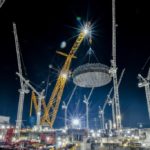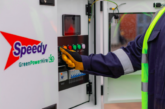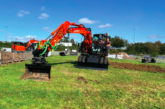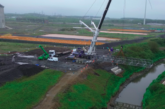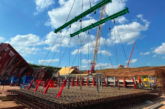The latest installment of the BBC’s documentary series on the Hinkley Point C (HPC) Nuclear Power Station was released this month, following the project’s biggest lift to date as part of the construction of one of the reactors.
The documentary series, Building Britain’s Biggest Nuclear Power Station, is currently airing and gives a behind-the-scenes look into the complexities of the project, engineering plans, and the tools utilized in its construction.
In order to complete the massive lifts required of the project’s heavy structural elements, developers contracted Sarens, a global leader in heavy lifting and crane services, who designed and created the world’s largest land-based crane for use at the site.
After beginning initial construction in 2014, HPC became the first new nuclear station built in the UK in over 30 years and when in operation, will power more than 6,000,000 homes. It is currently the largest construction project underway in Europe and will cost an estimated £22 billion to complete.
Project Background and Crane Specifics
Sarens was contracted for the heavy lifts required for the construction process by Bylor, a joint venture project by Bouygues Travaux and Laing O´Rourke that has been delivering the main civil engineering works at HPC, also erecting 50 of their own tower cranes for construction.
The SGC-250 crane, otherwise known as Big Carl, was transported to Somerset from Sarens’ headquarters in Wolvertem, Belgium in 2019. This model as well as other Sarens Giant Cranes (SGC) models were designed to meet the increasing demand for cranes with extremely heavy lifting capacity. Coming from Sarens’ headquarters in Belgium, the SGC-250 was transported in pieces via ship.
Throughout the project, the crane will be relocated around the construction site, which is why it was specifically designed to have a flexible and dynamic set of wheels to allow of 360° slewing and travel even when fully rigged. This will greatly increase efficiency while performing over 700 lifts over the next 5 years.
With the new nuclear power station, the UK comes closer to its goal of providing low carbon electricity to meet 7% of energy demand via nuclear power. The HPC plant is expected to operate for up to 60 years while also offsetting 9 million tons of carbon dioxide a year.
Documentary Release
The new BBC documentary follows the Sarens team as they complete one of the project’s biggest and most prominent lifts to date, which took several months of planning before its execution. Composed of multiple episodes, the documentary provides a closer look into the unique challenges faced by engineers on this project, which is owned by EDF Energy.
The onsite team, made up of more than 5,000 engineers and workers is shown explaining to viewers the long planning process that went into the successful completion of lifting one of the first structures of the nuclear reactor into place. Footage of Sarens’ operators working overnight to complete this lift during several hours demonstrates the extreme precision required to ensure absolute safety for the nuclear project, revealing that missing the target by even 50mm when lowering the dome into place could have offset the lift and set the project back for months.
The project is expected to wrap in 2026, and the documentary will include at least 2 more episodes throughout the construction of this pioneer nuclear power station.
The most recent episode of the documentary series can be viewed below.

